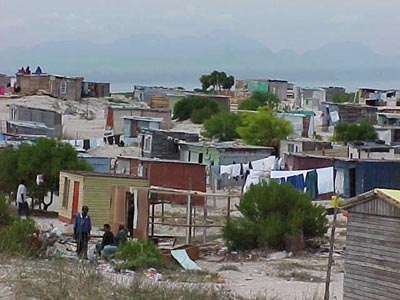the most “developed” country in sub-saharan Africa – but averages deceiving here



Context:
the most “developed” country in sub-saharan
Africa – but averages deceiving here

Extremely wealthy, white
minority with a life expectancy of 73;
just the white population
would rank as the 24th wealthiest country in the world; rakes in half
the
country’s income
Black majority indigenous
peoples
(incl. Zulu, Chosa, N Sotho, S Soth, Tswana, Tsong, S Ndebele, Venda)
each
has own language, culture; but most poor, poorly educated; illiteracy
rate
was 50% in 1994; life expectancy of 57
“Coloureds” mixed race
Indian (2%) immigrants (2nd, 3rd, 4th
generation) from India
Colonial History
Dutch East India Company est’d way station
at the Cape of Good Hope in 1652
indigenous people Khoikhoi (the Dutch
called them Hottentots) wiped out by smallpox;
Dutch then imported slaves from East Indies (Malays) and Madagascar – these are the ancestors of S Africa’s “coloured”
Dutch settlers – The
Boers
Frontier mentality
Symbol – the laager (wagon circle)
Lots of parallels between S African history
and US history in terms of genocide of indigenous people, import of
human
chattel, slavery, land settlement/homesteading, discovery of precious
materials
Exhausted soil, then pushed into interior,
wiped out the San (“the Bushmen”)
The Kaffir Wars lasted
over a century
as the Boers pushed toward Indian Ocean,
they met with Africans fleeing British slavers, tribal wars
As a by-product of the Napoleonic Wars in Europe, S Africa was ceded to Britain from the Netherlands (Napoleon occupied the Netherlands in 1795; becomes official in 1814)
The British abolished slavery (1834)
The Great Trek – the Boers set out to flee British rule – caravans as in Am West
clash of cultures between
voortrekkers
and indigenous people, as in US, didn’t
believe in land ownership;
Boers settle in Natal only to have it annexed by the British (1847); then Transvaal and Orange Free State until diamonds discovered in Transvaal (1867)
The Boer War (between teh
Boers and the
British) (1899-1902)
British win but Boers outnumber them and
takeover politially anytway
1914 founding of the
National Party
uses symbol of the laager; doctrine of
white supremacy; fascism as rising in Europe during interwar pd.,
spurred
by Great Depression
Establishment of
apartheid system
350 laws passed between 1913 and 1984
e.g. Land Act (1913) prohibiting Afr land
ownership outside of reserves;
Group Areas Act (1950) residential segregation;
Native Act (1952) nonwhites must carry papers;
Native Laws Act (1952) nonwhites
not allowed in urban areas for more than 72 hrs;
other laws prohibited nonwhites from working in skilled mining jobs, req’d separate public accommodations (like Jim Crow), outlawed protests, denied university education, allowed police to hold anyone suspicious for up to 90 days with trial, recourse;
1970 – Bantu Homelands
Citizenship Act
-
deprived Africans of SA citizenship; made
them citizens of their “homelands” (Bantustans)
1984 – half hearted reform; gave Coloureds
right to vote
3 chamber system – House of Assembly (whites,
178 seats); House of Reps (Coloureds, 85 seats) House of Delegates
(Indians,
45 seats)
whites controlled everything still
**1960s movement
African National Congress
Nelson Mandela, leader, imprisoned from
1961-1990!!

End of Apartheid
1980s President Pieter W. Botha
some concessions to Africans– right to
join trade unions, repealed mixed marriages act and ban on interracial
sex
International community
finally rallies
imposes sanctions on SA; bars from international
competition, calls in foreign loans
rand plummets, economic recession
Successor F.W.
deKlerk
reads the writing
on the wall
Releases Mandela from prison, legalizes ANC, invites back dissidents to negotiate transition
ANC demands end to “emergency rule” and amnesty for all political prisoners, exiles
Zulu-based party – Inkatha Freedom Party (Chief Mangosuthu Buthelezi) opposed to single state, i.e., wants African state
Other more radical,
distrusted ANC,
e.g. Pan-Africanist Congress, S Afr Communist
Party
New Constitution
free elections (April 1994), universal
sufferage, 400-member assembly, federalism – provinces
Nine official African languages along with English and Afrikaans
Mandela elected president;
Mbeki as first dep pres, deKlerk as second**
(note: powersharing transition)

Legislative
Branch:
Bicameral Parliament consisting of the
National
Assembly
400 seats; members are elected by popular vote under a system of
proportional representation to serve five-year terms
2004
Election Results
National
Council of Provinces
90 seats, 10 members elected by each of the nine provincial
legislatures for five-year terms; has special powers to protect
regional interests, including the safeguarding of cultural and
linguistic traditions among ethnic minorities
Judicial Branch:
Constitutional Court; Supreme Court of Appeals; High
Courts; Magistrate Courts
Mandela era
Reconstruction and Development Program
(RDP) over half a million homes get electricity in two yrs., hundreds
of
thousands get running water
but only a fraction of new homes built;
Mar 1996 RDP ends
Land reform, restitution still burning issue (literally in neighboring Zimbabwe!!)
Truth Commissions –
holding people accountable for violence
perpetrated in the 1970s and 80s
Economy
still in doldrums; protectionism, high
prices the norm
Price of inequality:
Very high
levels of crime; whites live
in armed fortresses, compounds; “gated communities”

Story on Economy, Income Gap
South African
10 Years After Apartheid (May 2005)